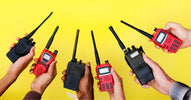
How To Tell the Quality of Used Radio Gear
, by Joseph Gabriel, 5 min reading time

, by Joseph Gabriel, 5 min reading time
Investing in quality two-way radio equipment means investing in effective communication for your organization, no matter the industry. Fortunately, this investment does not need to break your budget. Purchasing used radio gear can be a cost-effective way to build your communication system or upgrade your existing setup. However, ensuring you’re investing in quality equipment is crucial to avoiding headaches down the line caused by equipment failures or incompatibilities. It’s important to take time to ensure the gear you’re buying is high quality so that you can achieve clear communication while saving money through used gear. In this article, we’ll examine how to tell the quality of used radio gear and what to look for when purchasing new equipment.
Whether you are purchasing gear online or in person, shopping from a reputable retailer or seller can help ensure you are purchasing quality radio equipment. While anyone could sell their used equipment on sites such as Facebook Marketplace, retailers specializing in radio equipment will ensure the used equipment they sell meets their quality standards. At Atlantic Radio Communications Corp., our technicians examine our used radio equipment to ensure all of our certified pre-owned two-way radios are functional, quality devices ready to improve your operations.
Asking the seller or previous owner about the gear’s history and previous usage can help you understand the equipment’s current condition. Professional-grade equipment often undergoes regular maintenance, calibration, and performance testing to ensure optimal functionality. Meanwhile, personally owned equipment may have varying levels of wear and maintenance depending on the owner’s care practices and usage levels. While neither history guarantees better quality equipment, knowing the history of the gear can provide a better sense of what issues to look for as you inspect the gear.
The first step in ensuring the quality of used radio equipment is to inspect the devices physically. A physical inspection can inform you of the wear and tear of the device and any potential current or upcoming functionality issues. If you plan to purchase your devices online, check the listings for images of the products and detailed notes from a physical inspection of the gear. When physically inspecting the equipment, we recommend considering the following factors.
Look for any signs of wear and tear on the equipment’s exterior, such as scratches, dents, or discoloration. These cosmetic imperfections may not affect the gear’s functionality but can indicate how well the previous owner cared for it. Minor scratches or scuffs are common in used equipment, especially for items that have seen regular use. However, extensive damage or deep dents could suggest rough handling and, therefore, potential internal issues.
After assessing the exterior, focus on the knobs, buttons, and connections. Test each knob and button to ensure they are responsive and not sticking. Stiff or unresponsive controls can delay communication and may also indicate underlying mechanical. Check all input and output connections for any damage or looseness, which could cause signal loss.
If the gear has a display screen, examine it closely for any dead pixels, scratches, or other issues that could make it difficult to read displayed information during use. A malfunctioning display screen can make processes such as switching operating modes take longer and lead to miscommunications between devices that send and receive written messages.
Once you examine the equipment physically and ensure it appears in good condition, it’s time to ensure the gear is in working order. Test the following functionalities, or ask the seller to do so if you plan to purchase online.
One of the most important functional tests is to ensure the equipment turns on properly. Turn the device off and on several times to ensure it can turn on without issues. Pay attention to the power switch’s operation, listening for any unusual noises during startup or shutdown. Even if a device is turning on, it may still be having issues during its power cycle, which can indicate other problems. This is because a smooth power cycle indicates that the internal components function properly and the power supply is stable. If the device doesn’t turn on or has issues during a power cycle, it will not be reliable on the job.
A stable tuning mechanism is essential for precise communication and avoiding interference with neighboring frequencies. Test the equipment’s ability to tune to different frequencies without skipping or drifting to ensure efficient tuning on the job. If you notice any issues or find that the equipment does not cover the frequency band your organization uses, the equipment will not suit your needs.
Unclear or distorted audio can lead to miscommunications and delayed response times. Assess the audio output quality of the gear before you buy it to prevent these issues from affecting your work. Look out for any distortion, noise, or other audio issues that could affect communication intelligibility. Test the equipment with any accessories, such as external headphones, that you plan to use with it on a day-to-day basis to get a sense of its quality.
Now that you know how to tell the quality of used radio gear, you can save your organization money while obtaining quality gear that will enhance your team’s communication rather than adding obstacles to it. By shopping from reputable sources, learning about the gear’s history, and conducting physical and functional inspections of used radio gear, you can ensure the equipment you’re purchasing is ready for use. These steps may add time to the radio equipment purchasing process. However, investing time and effort in evaluating the quality of used gear upfront will save you from costly repairs, replacements, or compatibility issues in the long run.
If you’re looking for reputable, high-quality used two-way radio equipment for your organization, Atlantic Radio Communications Corp. can help. Check out our selection of used radio equipment for products certified to meet your needs in a cost-effective way.
